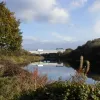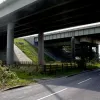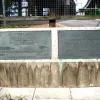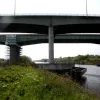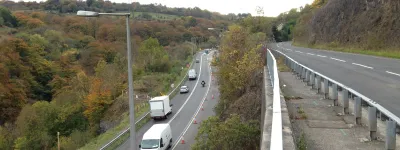The M6 between junction 20 and 21 is carried high above the Manchester Ship Canal and River Mersey by a structure known nationwide — the Thelwall Viaduct. Millions have passed over it since it opened in the early 1960's. Since then, it has been altered, fixed, fiddled with and duplicated at great expense.
The new viaduct was built as part of works to widen the M6 in the early 1990's, and shortly after it was finished, the old viaduct was refusbished. There were only a few years where the whole thing was open with four lanes each way before it was closed again for these works.
But there can't be many people who have much idea what it looks like — drive over and you won't see any of it. What form does this mighty structure actually take? I went out for a walk and found out.
From the overbridge at junction 21, the Thelwall Viaduct is obvious, picking the M6 up and forming a gentle arc from the next mile or so of tarmac. It's quite graceful. The reason it also looks peaceful is that there's nobody on it — the original one at least.
Meanwhile, the new viaduct is carrying six lanes of traffic (the width those lanes are in order to fit onto a five-lane carriageway is obvious). Currently the old viaduct is being repaired to fix some serious weaknesses, and consequently, traffic has been shifted off it.
Approaching from the west along the banks of the River Mersey, the Viaduct may as well be a regular river crossing.
The view near the southern end is slightly more surreal — an enormous bridge that, at this point, is just crossing open fields. It looks very out of place. This view is from the east, with the new Viaduct in the foreground.
Beneath the northern abutment, the original Viaduct is to our left with its huge embankment spreading out around it. To the right is the newer Viaduct, which is an altogether smaller and lighter structure, which steps across the embankment to a more modest landing site.
Opposite the abutments are the northernmost piers. It's clear again how much civil engineering has advanced in the space of thirty years — compare the size of the supports between old (foreground) and new (background).
At the opposite end, the viaducts are further apart where they hit the southern embankment. It's hard to appreciate the scale of these structures from the pictures — to get things in perspective, take a look at the steps that climb the embankment between the Viaducts. This photo also gives our first real glimpse of the scale of the works on the old Viaduct.
Facing the photo above, on the other side of Warrington Road, are these, which I hadn't expected to find. They commemorate the opening of the viaducts — though both date from the opening of the new Viaduct, as both mention the Highways Agency, and the left hand one mentions the widening works.
The view through the mesh fence behind the plaques shows the contractors' Portakabin village (complete with semi-permanent car park) and more of the huge scaffolding towers. It appears that some piers were replaced recently, perhaps when the Viaduct was refurbished, as these thicker, whiter columns have no scaffolding around them.
The best views of the Viaducts are, naturally, around their main spans across the Ship Canal. This is the view from the Trans-Pennine Trail, approaching the crossing from the east.
In comparison to the slender and quite elegant profile to the new Viaduct, this view from the west shows the old one in all its chunky, industrial-strength glory.
Looking side-on from the east once more, it's clear that the new Viaduct is built in a completely different way. Its piers are spaced differently and, as a result, it has a shorter main span, with one pier quite some way in to the Canal.
Both Viaducts curve slightly to the left when facing north. Though it's virtually invisible on the road, from underneath, it's clear that the deck is tilted slightly to provide some banking. The new Viaduct has angled piers, but this view shows that the old Viaduct has three bearings higher than the rest on top of each pier. Look closely at the beams emerging on the right hand side.
It's incredible that the old Viaduct used to carry all six lanes of the M6, plus a central reservation. Currently it carries four and a hard shoulder, which seem to fill it comfortably.
Looking south from the Ship Canal, first from the east, it's clear how much more slender the new Viaduct is compared to the old one. The appearance of the old Viaduct is, of course, worsened by the forest of scaffolding underneath it.
In between the two. At the time this photo was taken, six lanes of traffic were to the left, and one lane was to the right.


